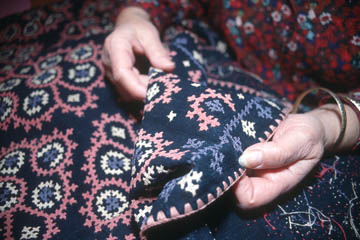
Many of us have family heirlooms — but how many have ones that were made in a far away country and date back to the mid-1800s? When Anahid Kazazian’s family fled their home during the Armenian massacre, and eventually made it to the United States, they brought with them treasured pieces of needlework with them. Including, this piece, which was made nearly 150 years ago by Anahid’s paternal grandmother, Lucia Dakessian, for her daughter’s trousseau. Anahid says, “We refer to it as gaghtnaker or “secret needlework,” because you can’t tell how the pattern is made by looking at it — you have to be taught.”
Anahid Kazazian will share her knowledge of Marash with visitors at the National Heritage Museum on Saturday October 11th from 1-3 p.m. She is a natural storyteller as well. Come learn about this sturdy and colorful needlework used to adorn textiles in the home for generations.
Listen to Kazazian’s audio stop from the Keepers of Tradition exhibition.

Hallo,
I´m writing a book about this embrodery in Europe between 1200 and 1600. I´m interested to have contact to people, who can give informations about the production of this embrodery (in Germany called orientalischer Flechtstich = oriental interlacing stitch or armenian stitch) in Armenian. Do you have a foto (JPG) of an old armenian embrodery that I can use in my new book about “Mittelalterlicher Flechtsticht – Bedeutung – Herstellung – Mustersammlung” (mediaval interlacing stitch – signification -production – pattern). Do you have the rights to let me produce it?
Best regards I.B.
Dear Mrs. Holtzberg,
I send the book in July but it came back from USA. Please send me the correct post address. KInd regards I.B.